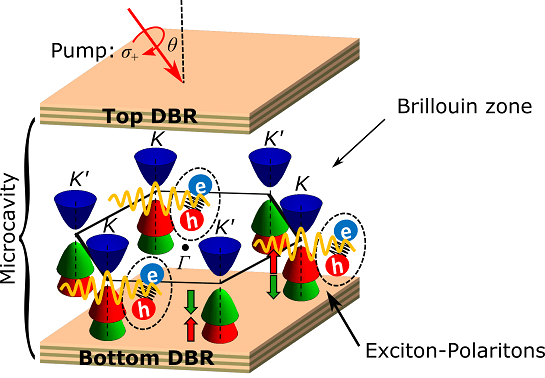Confining photons to small volumes can enhance light-matter interactions and lead to quantum states formed by coherent superpositions of light and matter. When coupling is strong, these quasiparticles can be thought of as half-light, half-matter excitations, following the framework of cavity quantum electrodynamics (QED). In semiconductors, these hybrid quantum states are known as “exciton-polaritons”, and they have traditionally been realized by embedding III-V quantum well semiconductors in microcavities. Microcavity exciton-polaritons have become a powerful system for studying many-body coherent phenomena in solid-state materials coupled with light1.
The same hybrid light-matter particles in quantum wells can also be realized in highly confined layers of transition metal dichalcognides (TMDs), which have novel valley structure due to their inversion asymmetry and spin-orbit coupling. Due to the strong exciton binding energies in the monolayer TMDs, exciton-polaritons survive to significantly higher room temperature2,3 in contrast to the single-digit Kelvin typical for those in III-V semiconductors.

In the Stern group, exciton-polaritons in MoS2, one of the materials in the TMD family, have been realized and confirmed with angle-dependent reflectivity measurements. Taking advantage of the energy degenerate K and K’ valleys in MoS2 with opposite Berry curvature, we study valley-selective exciton-polaritons: light-matter quasiparticles that respond to cavity QED fields of opposite helicity depending on their valley pseudo-spin index (Fig. 1). The dynamics of the valley-selective exciton-polaritons are distinct from valley excitons due to the strong coupling to cavity photons, which modifies the relaxation dynamics due to the photon insensitivity to polarization coupling4. Our work demonstrates that valley pseudospin can be preserved in light-matter superpositions with modified dynamics, which can help pave the way for polarization-sensitive polaritonic devices with an additional valley degree of freedom.
- H. Deng, H. Haug, and Y. Yamamoto. “Exciton-polariton Bose-Einstein condensation.” Rev. Mod. Phys., 82, 1489 (2010)
- X. Liu, T. Galfsky, Z. Sun, F. Xia, E. Lin, Y. Lee, S. Kéna-Cohen, and V. M. Menon “Strong light–matter coupling in two-dimensional atomic crystals.” Nature Photonics, 9, 30-34 (2015)
- S. Dufferwiel, S. Schwarz, F. Withers, A. A. P. Trichet, F. Li, M. Sich, O. Del Pozo-Zamudio, C. Clark, A. Nalitov, D. D. Solnyshkov, G. Malpuech, K. S. Novoselov, J. M. Smith, M. S. Skolnick, D. N. Krizhanovskii, and A. I. Tartakovskii “Exciton–polaritons in van der Waals heterostructures embedded in tunable microcavities.” Nature Communications, 6, 8579 (2015)
- Y. Chen, J. D. Cain, T. K. Stanev, V. P. Dravid, and N. P. Stern “Valley-Polarized Exciton-Polaritons in a Monolayer Semiconductor.” Nature Photonics 11, 431 – 435 (2017)
